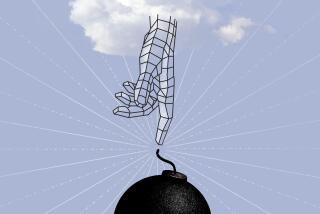Postscript : Jules Verne’s Dark Vision of Modern Life : His ‘lost’ manuscript speaks of an advanced but joyless society propelled by the ‘devil of money.’
- Share via
PARIS — Horse-drawn carriages clattered on the streets outside Jules Verne’s Paris apartment, but it was quiet inside. There was no telephone, no phonograph and no radio--they had yet to be invented.
The year was 1863. Soldiers armed with muskets were fighting the Civil War across the Atlantic. Workers were digging London’s first subway line. And, in Paris, the man who would become the best-selling French author of all time, taking readers on extraordinary voyages in “Twenty Thousand Leagues Under the Sea” and “Around the World in Eighty Days,” was imagining a bleak future.
The only thing Verne could not have predicted was that a book he had written, rejected by his publisher, would wait 131 years, until 1994, to be published.
Verne was 35, with one highly acclaimed book to his credit, when he began writing “Paris in the Twentieth Century” by hand, in a small and delicate cursive. (The typewriter wouldn’t be invented for another decade.) His pages were illuminated by a small gas lamp, electric lights being 15 years away.
The book’s protagonist, Michel Dufrenoy, lived nearly a century in the future, in the year 1960. Technology and automation had supplanted the culture of the 1800s. Elevators whisked people up and down buildings. Trains took them back and forth from the suburbs.
Images--he called them “fac-similes”--could be sent thousands of miles away by “photographic telegraph,” something we might today call a fax machine. Neon lights, unknown in 1863, illuminated Verne’s avenues. Concerts were performed in 10,000-seat auditoriums by single artists using electric amplifiers.
And, “of the innumerable cars that passed on the paved roads, most moved without horses,” he wrote, 25 years before the first prototype of an automobile was built. “They are propelled by an invisible force, the force of 20 or 30 horses, by means of a motor run by gas combustion.”
Verne’s heroes, though, “no longer stood in admiration of these marvels,” he wrote. “They just quietly took advantage of them, without being any happier, because of their speeded pace and their American passion. One could feel the devil of money pushing them forward nonstop and without mercy.”
When Verne’s editor, Pierre-Jules Hetzel, one of France’s most renowned book editors, read Verne’s manuscript, he was not impressed.
“My dear Verne,” Hetzel wrote, in the sort of soothing rebuff that authors dread, “I would give, I don’t know what, to not have to write you today.
“You have undertaken an impossible task--as do all those like you who can see in the future,” Hetzel wrote. “But you haven’t succeeded. I wasn’t waiting for something perfect, but I was awaiting something better. I would consider it a disaster for your name to be associated with this work.”
Hetzel didn’t stop there.
“It is 100 steps below ‘Five Weeks in a Balloon,’ ” he said, referring to Verne’s first success, which had appeared the same year. “If you wait a year, you will agree with me. It is a little story and on a subject that isn’t happy.”
With that rebuff, the respectful author locked the manuscript, and its dark vision of the future, in a safe.
He went on to write “Journey to the Center of the Earth” and 60 more novels, tales of imaginary, futuristic expeditions more filled with wonderment than dread.
The safe remained in Verne’s family after his death in 1905 at 77. Remarkably, no one tried to find the manuscript, though it was officially listed at his death as being among his unpublished works.
But the author’s great-grandson, opera singer Jean Jules Verne, 31, remembered well that safe, which the family had lugged from place to place.
“It was an obsession of my childhood,” Jean Verne has said. “I spent many long afternoons trying to open it. I tried all the keys of the house and others that fell into my hand. It represented for me an unsolvable mystery.”
*
Finally, in 1989, using a blowtorch, Jean Verne opened the safe. Inside were a few Russian bonds, an unfinished play and the unedited manuscript titled “Paris in the Twentieth Century.”
The manuscript’s authenticity was verified by experts, and the 218-page book, with illustrations by a modern-day Belgian artist, Francois Schuiten, was published a few weeks ago in France, drawing admiring reviews.
“It reads today like a prelude to all his fiction,” wrote a reviewer in the Paris daily newspaper, Liberation. “Hetzel (Verne’s editor) never understood that the most prestigious of his authors was in fact a writer . The book may lack some bounce, but it certainly doesn’t, as insinuated by Hetzel, lack originality.”
Hetzel discovered Verne in 1862 and, during their close 20-year relationship, used his skills to establish Verne’s reputation. To the editor, whose other writers included Alexandre Dumas and Victor Hugo, “Paris in the Twentieth Century” was a downer, not very marketable.
But novelist Bertrand Poirot-Delpech, one of France’s most-respected literary critics, says the book shows again Verne’s “distinct genius to deduce the future, not from a dream with eyes closed but from an intense observation of the present.”
Nevertheless, this sad and nightmarish vision of the 20th Century has come as a shock to many readers. For all the technical wonders Verne imagined, and largely because of them, Verne’s Paris, circa 1960, is a forbidding place.
Pollution is as thick as the London fog, the countryside has disappeared, traffic jams clog the streets and tall buildings mar the Parisian sky. Offices are protected by security alarms, and, as one character puts it, “laughter is punished by the death penalty. In this century, we’ve got to astonish people. One can’t charm them anymore.”
The hero, Michel, dreams of becoming a poet. But classical culture has been driven away by the overpowering need to make money, and the young man winds up broke and miserable. “Latin and Greek are not only dead languages, but also buried,” Verne writes.
In Verne’s vision, marriage has become “a useless, almost heroic act,” and children born out of wedlock far outnumber those born to married couples.
Even the Parisian woman has been transformed. “She is a butterfly who has returned to being a caterpillar,” he writes. “Her caressing way of walking, her grace, her amiable smile, her slight plumpness have all been replaced.
“She has become an American,” he continues. “She speaks gravely of serious business, dresses badly, without taste, and wears a strong iron corset.”
*
Simone Vierne, a literature professor in Grenoble and author of “Jules Verne, Myth and Modernity,” argues that the author’s great gift was not in telling the future, but in following scientific advances to a logical conclusion.
“The lost novel shows clearly that Verne’s genius was not to have anticipated technological progress, but to foresee its troubling consequences for human beings,” Vierne wrote in the newspaper InfoMatin.
“Now that we have walked on the moon and surpassed most of his inventions, it’s time to take this into account,” the professor added. “The world where money and technology rule is not, as we well know, the best of all worlds.”
Jules Verne Facts
Born: Feb. 8, 1828, in Nantes, France.
Career: Known as the “father of science fiction,” he abandoned a mundane career as a playwright and wrote more than 60 books portraying then-incredible events, from outer space travel to submarine exploration. He became France’s best-selling author.
Died: March 24, 1905, in Amiens, France.
Some of his popular works:
* Five Weeks in a Balloon (1863). Tale of a bizarre journey in a hot-air balloon.
* Journey to the Center of the Earth (1864). Two groups of explorers race to the Earth’s core to discover a new land.
* From the Earth to the Moon (1865). An outer space adventure.
* Twenty Thousand Leagues Under the Sea (1870). Seamen take up with the peculiar Capt. Nemo, commander of the first submarine.
* Around the World in Eighty Days (1873). Another adventure tale in a hot-air balloon.
Compiled by Times researcher LAURA A. GALLOWAY
More to Read
Sign up for our Book Club newsletter
Get the latest news, events and more from the Los Angeles Times Book Club, and help us get L.A. reading and talking.
You may occasionally receive promotional content from the Los Angeles Times.







